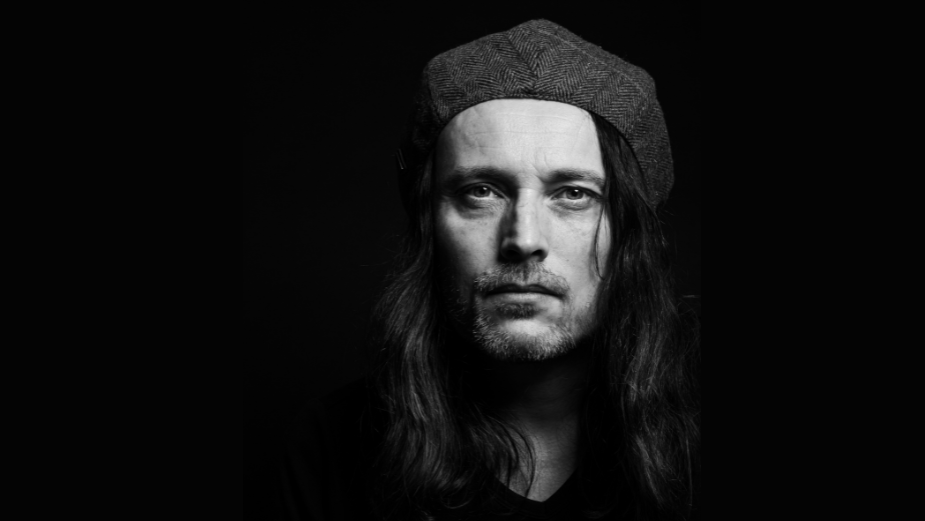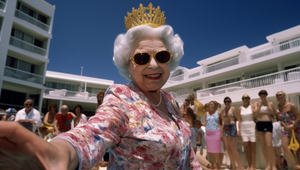
The Blind Photographer Talks 3D Images, Rankin, and Finding Passion Through Panic

Ian Treherne calls himself ‘The Blind Photographer’ to hurt people’s brains. It’s a set of words that just doesn’t compute – until you start to understand blindness better.
It turns out, only a small percentage of legally blind people have no sight at all. In Ian’s case, he was diagnosed with RP Type 2 Usher Syndrome at age 15, a condition which combines congenital deafness with a progressive tunnel vision. Dealing with the feelings of isolation that ensued, he picked up a camera as a means for documentation, self-expression, and connection with others. He’s been following that creative calling ever since.
Now, Ian is represented by production company Annex. He’s collaborated with the likes of Apple, Canon, the Paralympics, and Rankin, primarily specialising in monochromatic portraiture. Fuelled by a natural curiosity, Ian works to capture his subject’s individual essence through light, texture, and atmosphere, both in studios and on location. By pursuing such a career, he hopes to showcase that a diagnosis is not the end of the story, busting stigma, amplifying diverse voices, and fostering inclusivity along the way.
To hear more about Ian’s story, creative perspective, and ambitions, LBB’s Zara Naseer sat down with the photographer.

LBB> How would you describe your visual identity as a photographer? What inspires it and what makes it unique?
Ian> I call myself ‘The Blind Photographer’, and that was a conscious decision I made only a few years ago. For a long time, I was a closeted blind person, so I didn't really tell too many people because I wasn’t yet comfortable with labelling myself and speaking about disabilities publicly. I didn’t want to be pitied or shunned.
I called myself a blind photographer to confront these challenges in my life and see if I could do something creative with it at the same time. I was interested to see where that would lead me. A lot of it is probably born of my stubbornness and persistence.
What does inspire it is looking at some of the younger generation now on social media that are being much more vocal about their disabilities. They definitely gave me confidence to open up about my disabilities and my creativity, and see how I could fit into the inclusion revolution.
I'm intensely curious about life and everything that surrounds it, so when I'm looking through my pinhole window of sight, I focus on what catches my interest and spotlight it. I don’t see everything, but I’m always trying to make sure I see something captivating.

LBB> What’s your favourite project you’ve worked on, and why?
Ian> Gosh, there are so many. There’s the recent one I did with the Paralympics, the one I did with Rankin… But my favourite is probably one I did this year, where Canon and Royal National Institute of Blind People (RNIB) had photographers display their work in Somerset House.
What was unique about this exhibition was that they didn't only have 2D imagery – they also had a 3D physical picture that you could touch. You could feel the face, the eyes, the hair. I was the only blind photographer there, so it was super cool to have my work exhibited alongside all these amazing, well-known Canon photographers. I felt like I must be doing something right, because I started learning from nothing. I didn't know how to use a digital camera until about 15 years ago. It’s been a learning curve that’s ended with me having one of my images in Somerset House for an exhibition called World Unseen.
I'm hoping this new tactile print technology is something that will be used in the future in more well known places like The National Gallery. It's a step forward, not just for blind or visually impaired people, but also for sighted people. It's all about mixing everyone, rather than separating everybody, which is what we've been doing for many years.

LBB> You’ve said that you were always creative from a young age – in what ways did that creativity manifest itself?
Ian> When I was diagnosed with RP Type 2 Usher Syndrome at the age of 15, it obviously changed my life completely. I didn't really know where I was going with my life, but I did know that I had creativity in my back pocket, and it took many years for me to bring those two together.
My eyesight condition is connected to my hearing, so I was born profoundly deaf. Growing up, I would draw and sketch with pencils with lots of shadows and highlights and contrast. The way that I drew as a kid transferred into my photography, almost as an unconscious decision. It just seemed to be something that I liked and that kept me focused and happy, because I was a very quiet kid.

LBB> What draws you to photography as your medium of choice, and how has it impacted your life?
Ian> The first camera I properly picked up was in my teenage years, in the ‘90s, when digital cameras didn't even exist. For me again, it goes back to when I was told at 15 that I was going to go blind. Suddenly, it changed my outlook on everything. I had this massive sense of panic that I needed to capture memories. But when I was taking pictures – and by the way, none of these were artistic or amazing photos, they were literally just snaps – I found it really exciting and thrilling. The camera made me feel how I felt about drawing. It gave me a sense of purpose and focus.
I’ve also discovered I’m neurodivergent, which has affected me all my life, but I hadn't even realised it until the last few years. That also makes it quite difficult to be part of society along with not being able to see or hear very well, so I’ve had to find another way to be a part of the world. The camera has been the bridge to connect me to society, and that still remains the same to this day.

LBB> You’ve mentioned before that you want to change people’s perceptions – what in particular do you wish more people understood?
Ian> Through the years of film and TV, blind people have been shown in a very generic, stereotypical way, where they’re fully blind with a cane or a guide dog. I want to change that typical idea of what a blind person looks like, because every one looks different. Totally blind people do exist, but they're a very small percentage of people in this country. We are now learning that it’s a spectrum: about 93% of people who are blind have some form of sight. It could be blurry, it could be a small window, peripheral, impaired. That’s why I decided to call myself a blind photographer, because I knew that it was literally going to hurt people’s brains – they’d think the two words can’t go together. People ask themselves, how does that even work? And if people they’re asking the question, that's a good start.

LBB> Why have you chosen Annex as the company at which you pursue your craft?
Ian> I was very blessed to meet Annex and Basil Stephens (EP and head of stuff) on a job back in 2021 for Irwin Mitchell called ‘Human Touch’. Annex aimed to engage as many crew members identifying as disabled as possible for the project, which comprised both film and stills. Ultimately, this group comprised 30% of the crew, myself included. I was hired to photograph the stills campaign and it was here that I had the fortunate opportunity to be mentored by Rankin.

There are so many people with disabilities who want to work but haven’t been able to get into the working world, and this project showed that it’s not about disabled people fitting into the able-bodied world; it’s about the two coming together and adjusting. Basil really understands that concept and has total belief in what I do and in educating himself. It was on this project that Basil met the director Owen Tooth, a wheelchair user who shot a series of documentary shorts about the campaign. Owen has also joined the Annex roster of talent.
I joined Annex this year to be able to work with a team of like-minded people at a company that wants to explore and adapt how it works. Rankin once said that the more people that you bring to the table, the better ideas you have, and it's true. You've got different mindsets from different backgrounds, and you can bring a different outlook to a project. Working with Annex, we're sort of educating one another on how to work in the industry, and how to work with a blind person.
It’s given me support in being able to do bigger jobs, because pretty much up until now, I've been doing everything all by myself – the lights, the styling, the organising, everything. Now I’ve got a small team behind me.

LBB> In the immediate future, what are your next goals as a photographer?
Ian> I’d really love to be doing magazine and fashion work in the future, portraiture photography for somewhere like Esquire or Vogue. I'd also love to be doing more documentation of social and political stories, and commercial work because it challenges my photography to think outside of the box. Every job I do, I’m always learning. I like trying things I’ve not done before.
I feel like I'm only just starting really in a lot of ways, only scratching the surface. I’ve got a lot of a long way to go yet. I’m looking to keep raising the bar and to get rehired rather than being a one-time box to tick.
















